Interview Patrick Kasingsing
Images World Architecture Festival and Duccio Malagamba for Mario Cucinella Architects


“I need an espresso, and then I can show you around,” the Palermo-born, 63-year-old principal of Mario Cucinella Architects (MCA) said with a weary smile as we marched to the speaker’s lounge at the World Architecture Festival (WAF) at the Marina Bay Sands in Singapore. After a swig from his paper cup, the refreshed Mario Cucinella ushered me toward the lozenge-shaped infographic display his studio prepared for their exhibition at the World Architecture Festival: ‘The Future is a Journey to the Past,’ which previously made a stop at London’s Architecture Association.
The installation is hard to miss; it’s a long, brightly colored wall nearly three meters tall. On its surface is a supersized timeline of sustainable thinking, starting from 10,000 BCE, when Stonehenge was completed, and during the advent of hypogean dwellings like the ones in Matera ‘Sassi’ in Italy and Matmata Village in Tunisia. The timeline runs its course, peppered with sustainability milestones, architectural achievements (with a few MCA projects here and there), natural and man-made disasters, alongside vital tomes and cultural (and pop cultural) touchpoints that have shaped public mindset regarding the environment. All this is overlaid against important chapters in human history. The timeline, naturally, is left open-ended.

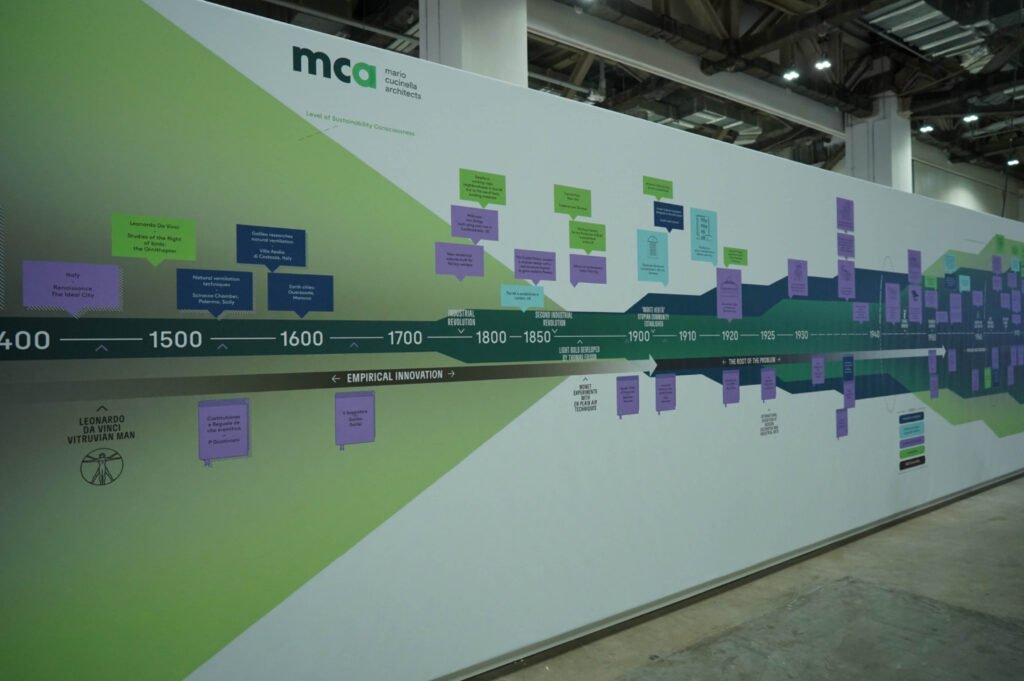
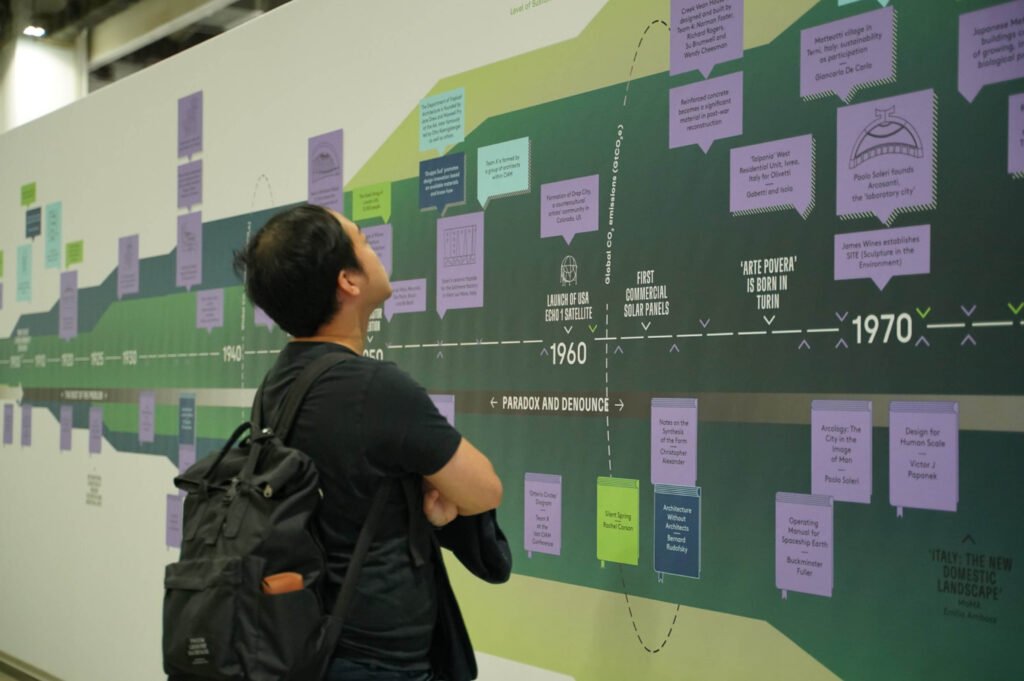
Sustainability at MCA is no mere PR packaging. The 31-year-old firm has long found renown for its sustainability-focused portfolio, with innovations such as the Tecla 3D-Printed House, a 3D-printed home prototype made of raw earth, the low-energy impact 3M Headquarters in Milan, and the prismatic Centre for Sustainable Energy Technologies in Ningbo, China.
Designing environmentally responsive buildings is but one aspect of the MCA sustainability agenda. Cucinella, alongside collaborators Clara Conti of SAIB, Federica Minozzi of Iris Ceramica Group Foundation, and Giacomo Maniscalco have instituted the SOS – School of Sustainability Foundation in 2015, which the firm describes as a “…school for young professionals and recent graduates that focuses on the application of sustainable architecture and design to give future decisions makers the tools necessary to tackle the environmental issues that are emerging globally with an open-minded, holistic, research-driven, and human-centered approach.”


Cucinella has also written multiple books about sustainability; his most recent one, The Future is a Journey to the Past – 10 Stories about Architecture (Quodlibet, 2022), lent its name to the exhibit, which shares its narrative of turning to the wisdom of the past to propel ourselves to cleaner, greener futures.
A quote from Cucinella’s website stands out: “Design for life and you design for beauty,”
It best sums up their studio’s ‘creative empathy’ dictum, laid bare in the exhibition and within MCA’s desire to remind fellow practitioners not to lose track of their calling, to shelter and harbor life.
Our interview and walkthrough of the exhibit with signor Cucinella follows.
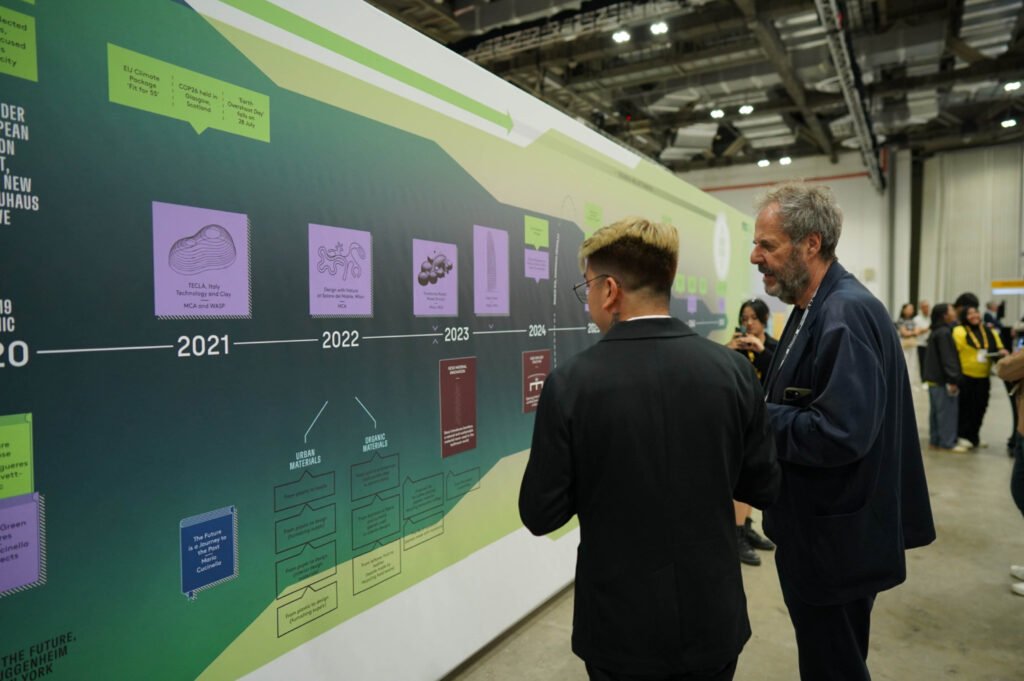

Mr. Cucinella, can you please give me a brief on your exhibit? What was the impetus that brought it to life?
Mario Cucinella, founder, and creative director of Mario Cucinella Architects: Sustainability appears to be a very contemporary debate, but it was not a debate in the past. People designed buildings then with the natural energy available—sun, wind, rain. There was no question about whether the structure was sustainable or not, it quite simply worked with the natural conditions.
So maybe we need to tell the stories of how we did all this before the Industrial Revolution, where the solution did not require as many resources but rested largely on the connection we shared, and our understanding of nature.
Right.
It’s amazing to think about how we used to design beautiful buildings that really connected with nature. For example, in ancient Persian cities, they used windcatchers to cool their buildings, and Roman engineering led to the design of efficient aqueducts. Then there are thermal baths, which could course hot and running water inside a building. There are so many interesting stories and solutions to glean from the past for present-day concerns if we just take the time to listen.
During the Industrial Revolution, there was a significant shift in how we harness energy using machines. This led to widespread change, including dramatically changing how we design and build architecture.
Yes, our buildings grew larger, taller…
Yes, but simultaneously, we have lost our once intimate connection with nature because we have become too dependent on our machines. We placed our confidence in the machines, as something we can control. While the world hurtled ever faster towards this mechanical dependence, not a few architects, writers and major thinkers have started to worry about this distancing from nature. There were designers like Ebenezer Howard who put forward urban planning approaches like the Garden City of Tomorrow…Le Corbusier, for example, was very concerned about access to air, light, and the sun, which he tried to respond to with his designs.
You could say that two major movements were running at the same time. You have economies growing faster thanks to industry, fueled by energy, and all that building, building, building. At the same time, a growing community of architects, designers, and thinkers were starting to get concerned and were already pondering the future that lies waiting for the world in its current trajectory.
You also have Buckminster Fuller here and his famous quote: “To do more and more with less and less until eventually, you can do everything with nothing,” his life’s work in service of better living conditions utilizing fewer resources.
During the Space Race, we could finally look back and see our planet, from the moon, realizing that we are but a tiny dot amidst the blackness of a vast universe. It really got us thinking about energy, our finite resources, and our future, all confined within that tiny blue sphere we call home.
It’s been quite a journey, our relationship with energy, from the combustion engine to assembly lines…and then you have the first atomic bomb detonated in Japan in 1945, and a few decades after, the launching of the first satellite into space. Running parallel to all these world-changing events, you have communities of hippies in the United States choosing to live very simply in the desert.
There have always been groups of people in history that have had their pulse on what we now call sustainability. You have Paolo Soleri in Arizona creating a new city informed by ecology… there’s artist Joseph Beuys in Germany who created the Green Party. When the crisis of using too much energy and polluting the planet arose, groups of people anticipated and were already trying to call our attention to these problems. And they tried hard, through literature, films, art…that’s the story.
I guess that is why, come 2015, we decided to create a school of sustainability, a postgraduate program in our office, so we can help the younger generation face sustainability issues practically and amplify the call to not turn a blind eye to the energy and environmental crises that are now our reality.


“If we think about the past, we’ve always had a need for a relationship with earth and all its energies, such as the sun, wind, and light. Our project for Nice re-establishes a symbiotic relationship between architecture and nature by interacting with the surrounding landscape, reinterpreting traditional Brazilian architectural elements, and encouraging users to take advantage of all its passive features.”
M A R I O C U C I N E L L A
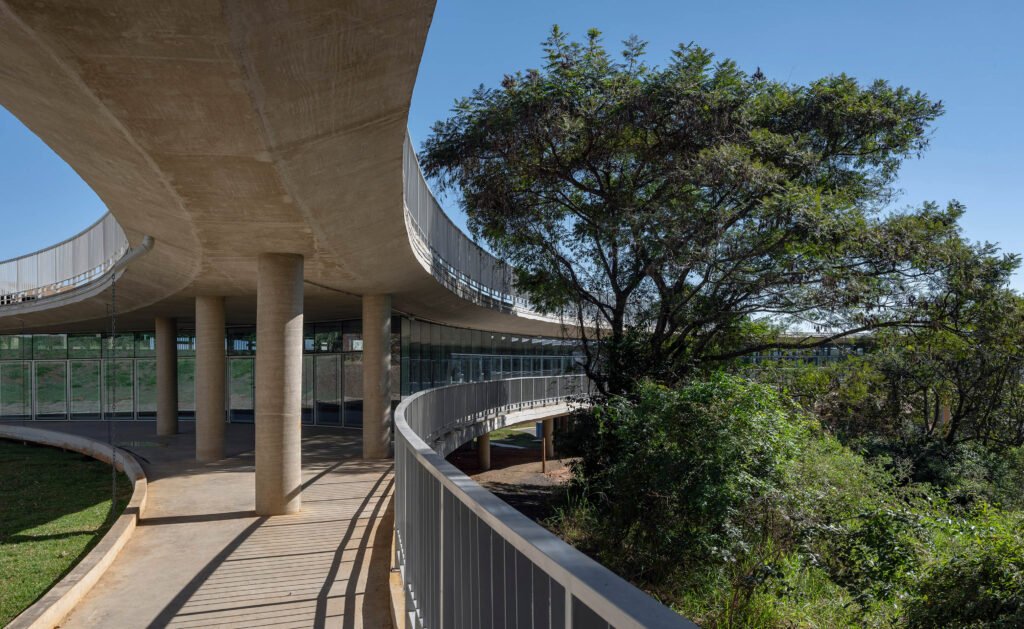

That’s great. We are coming to the end of the timeline. The ending is open-ended…
Right. You have here the SDGs of the United Nations, the 17 points concerning the planet’s future. The European roadmap in 2013—ecological justice, nutrition. So, this is the focus now. We know the problem, have posited solutions, and now we see how our collective efforts pan out. But there is still so much to do and many questions to answer. How can we improve the quality of our cities and reduce the impact of emissions? We do have some big steps to make. In 2050, for example, Europe aims to be climate-neutral.
Wow.
Yes, it’s a very ambitious program, and it involves a lot of adjustment in terms of architecture and urban design. But that is how it is if we want to increase our chances of survival.
We’ve come to the end of the timeline in this display. The story of sustainable thinking, which may seem like a contemporary concept, has existed for millennia. We’ve remembered, and now we must listen to our past.
Right, and this also is the narrative of your book right here with the same title?
Yes, you are right. However, the lens and structure of the book are naturally quite different. The book tells the story of architecture, revisiting and explaining how we were empathetic with nature and climate before the Industrial Revolution, seen through the stories of ancient buildings in India, China, Africa, Saudi Arabia, and Europe, all utilizing zero energy.
The future is a journey to the past because maybe the future is not all that is in front of us. It’s also what’s behind us—the knowledge we had for many centuries, created, adopted, forgotten. If we want to be net-zero, or carbon natural, we need to reduce our environmental impact. That’s the point.


“Designing a church is a message of continuity with the spirit of art that has passed unperturbed through the centuries of humanity.”
M A R I O C U C I N E L L A
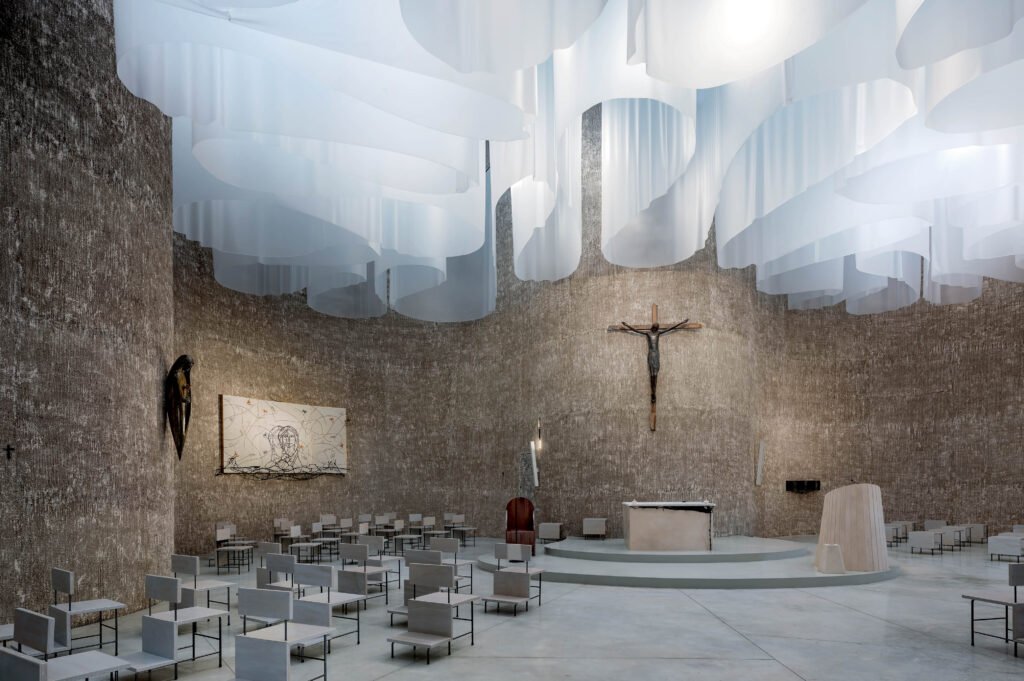

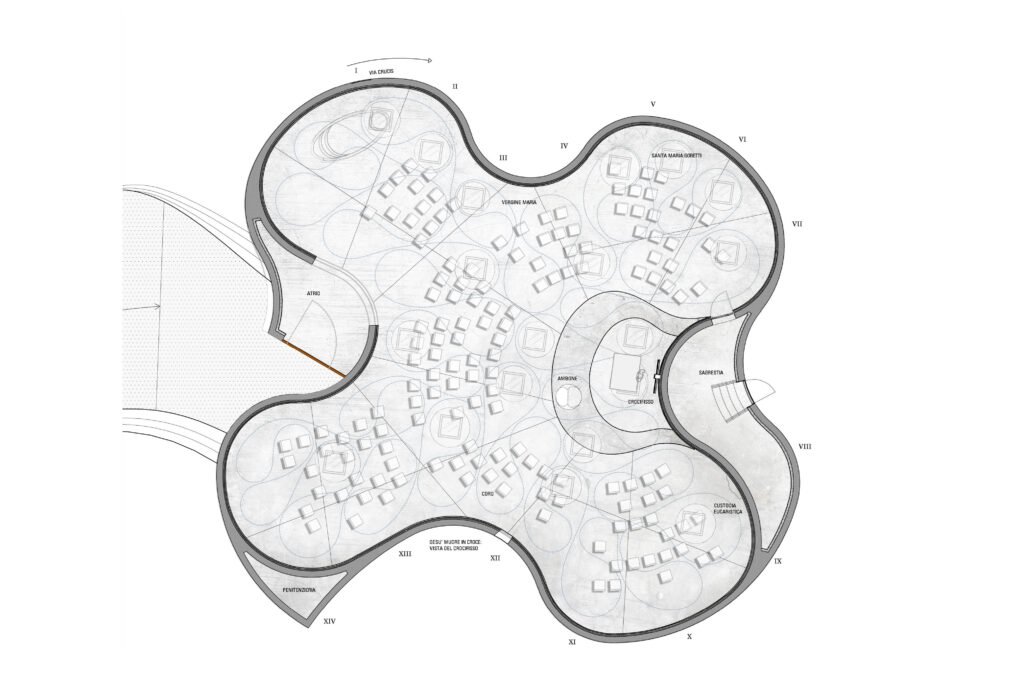

Why do you think an exhibit like this is the best form or the most effective way to communicate your message? Why at WAF?
Because the international community of architects is here. WAF is the best forum and space to share something like this for greater impact. In the context of global projects and high-quality architecture, this exhibition tells people the way, the road we need to take to move forward to a more desirable future. It’s a good community to talk to: you have architects, designers, students…
It seems that by presenting information in this way, you are communicating the truth of a situation while giving individuals the opportunity to approach it with their own unique perspectives and ideas. While the end goal is clear, the path ahead requires collective creativity and resourcefulness.
Yes. In architecture, what to do is already regulated for sustainable buildings. There is a lot of knowledge, but the problem is translating that knowledge into buildings that nurture and not just shelter.
This is more an architectural problem—the attitude of architects in relation to climate. A building shouldn’t just be a sustainable container. It must appeal to the human being, a lifeform capable of seeking ideals like beauty. That is why we believe in designing for life, which in turn, leads us to design for beauty. This is one thing many forget when designing so-called sustainable buildings.
The goal is not only technical performance but quality of life. Buildings can undoubtedly make a difference in people’s quality of life. We need to put the human side of buildings at the center of our work. It’s not just a technological exercise. People live in our buildings, and they need to live better. That is the issue.
There is no other way to design buildings at MCA except sustainably.
Precisely. All new buildings should really be sustainable. We aim to design buildings that do not consume too much resources and work with nature instead of against it. Mankind was able to do so for many centuries. In the last century, we designed buildings against the climate and nature. And now nature has presented us with the bill—and it’s a very expensive bill. Like in any broken relationship, we need to revisit the cause of friction, repair the roots, and be more empathetic this time around. To rekindle our damaged relationship with nature, we must design alongside her and be more mindful of how our work affects her. When we design for nature, we design for ourselves.
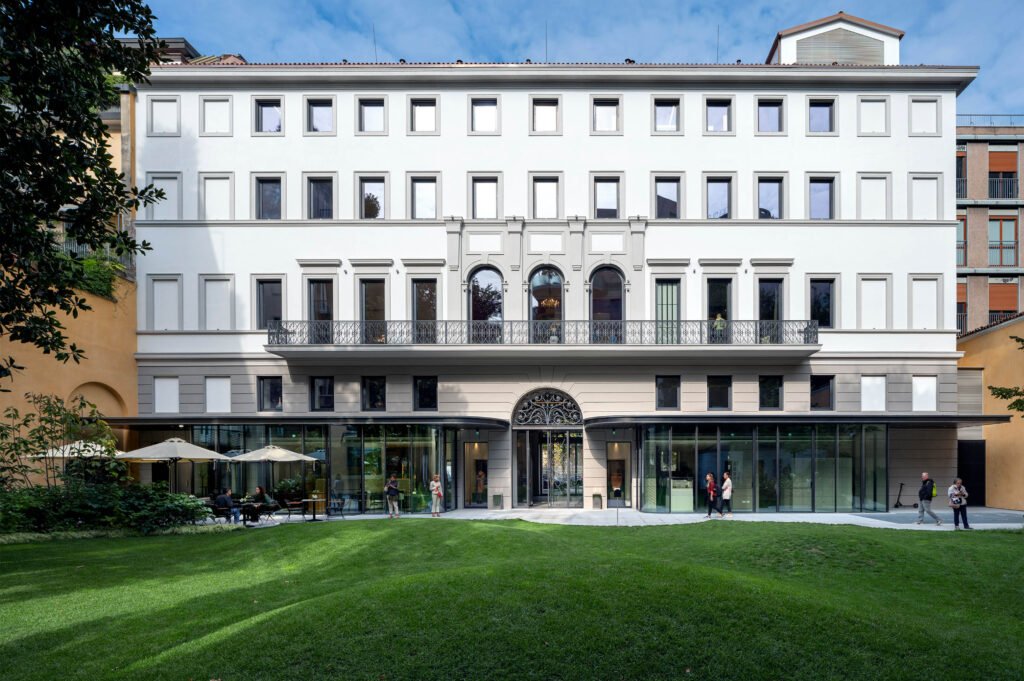

“By thus recovering a building, the Fondazione Luigi Rovati is expressing the fundamental concepts of sustainability, of recovery, of focussing on energy and consumption issues, and on the reuse of materials; but the special attention that has been given to the conditions of well-being for visitors, researchers and staff. Architecture and art are also a form of care; they enter into us, creating emotions, imagination, and memories. This is a way of caring for people; an attentiveness that is the most genuine expression of sustainability”
M A R I O C U C I N E L L A




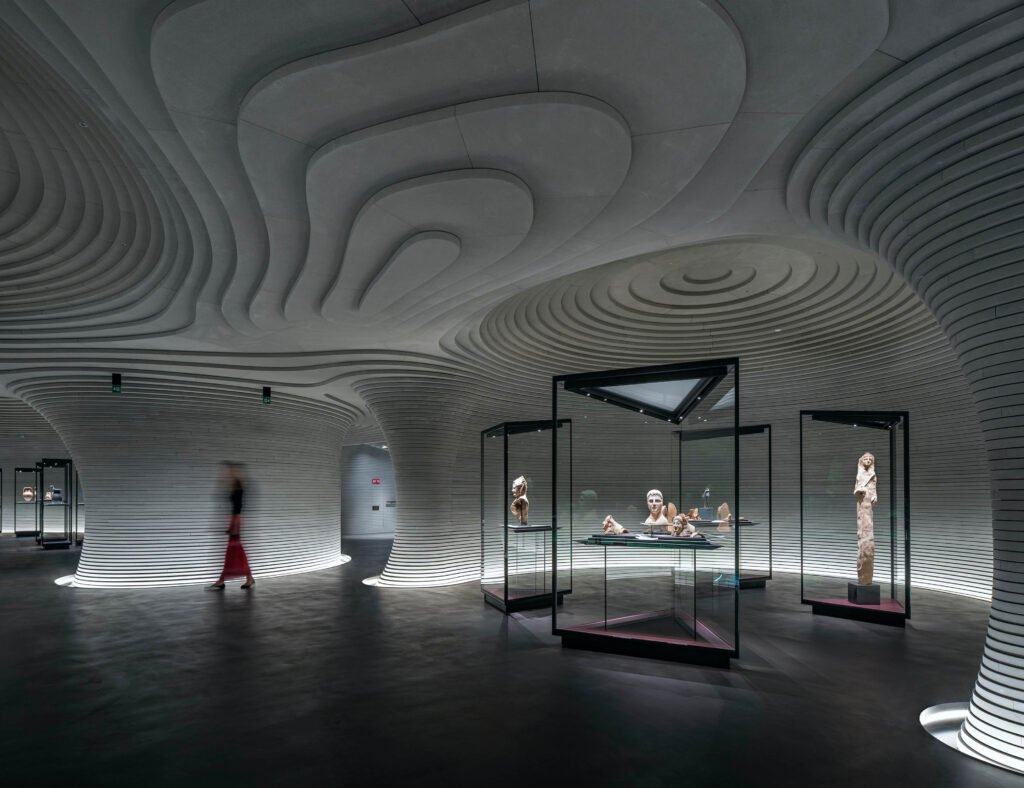

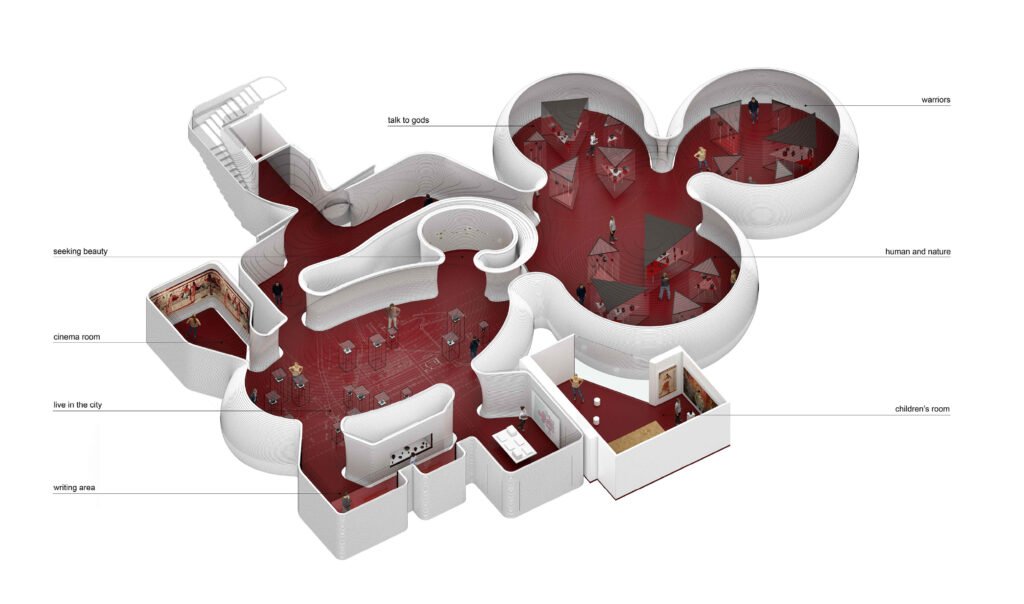
The situation as of late is dire, but the exhibit, with its emphasis on collective efforts and sustainable breakthroughs, emanates hope and defiant optimism. In the news, we hear about rising temperatures, water levels, and a generally negative prognosis for the planet. What gives your studio hope anyway for the future?
That’s the mission of an architect, right? You must always be hopeful if you’re an architect. You need to be positive because architecture is something you design now but build after three, four, or five years. You need to be optimistic.
There are still a lot of problems on this planet—wars that kill thousands of people, problems about the industry wanting to produce a lot, consuming a lot of land, consuming a lot of energy, pollution…Architecture is one part of the story, but it carries an impactful role in our shared future. This exhibition is us walking the talk but also sharing that there is still good news on the horizon for mankind, there is still hope, there is still a solution, so let’s talk, let’s discuss, and let’s collaborate to realize a better future.
This exhibit reminds us of the wisdom we can still learn from our ancestors. To close, what other important lessons from the past do you think more architects should be reminded of?
The way people used to think when designing buildings was based on an understanding of nature, climate, and local culture and tradition. However, we have forgotten this important relationship and instead designed buildings that look the same everywhere. We must remember this relationship and design buildings that are unique to their local context. Designing this way, we celebrate sensitivity, community, and diversity.
Grazie, Mario! Thank you very much for your time! •


